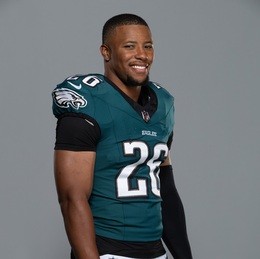
The drive is 97 miles. If you hit the traffic right, it takes maybe 95 minutes. Head up Broad Street a few blocks, cross the Walt Whitman Bridge and head up I-295 to the Route 73 linkup with the New Jersey Turnpike. Then it’s a straight shot north to get from where the Eagles practice and play in South Philadelphia to the New York Giants’ home in East Rutherford, N.J.
There are places in Central Jersey where Giants flags and Eagles flags alternate on the same block. South Jersey, of course, is Eagles country. But if you live here, you know a decent number of Giants fans have filtered down our way; sometimes they just find it wise not to make too big a display.
Yet Saquon Barkley frequently prefaces his remarks with the phrase “from afar” when he’s asked to recall his impressions of the Eagles and Philadelphia during his six seasons as the Giants’ centerpiece. As if he’d been tracking the Eagles from Iowa, or something.
If that really was the running back’s perspective, maybe it helps explain why Barkley was unprepared for the avalanche of abuse that chased him down the turnpike after he signed a three-year, $37.75 million contract—$26 million of it guaranteed—with the Giants’ closest and most hated NFC East rival.
When Barkley was booed by New York fans while attending Game 6 of the Sixers’ playoff series with the Knicks, he took to X, formerly Twitter, to muse: “It’s been two months ... lol no way ya can still be this mad.”
Later, on the Scoop City podcast, Barkley said he had to acknowledge that being dubbed “Snakeqoun” by jilted Giants fans was pretty funny.
The wound was kept fresh by the Giants’ appearance on HBO’s Hard Knocks. The show documented the events around Barkley’s departure, including when general manager Joe Schoen told owner John Mara that the Eagles were a possible destination once the Giants sent Barkley out to seek a deal in free agency (which they said they hoped to match, but ultimately, did not.)
“I’ll have a tough time sleeping if Saquon goes to Philadelphia, I’ll tell you that,” Mara said in front of the cameras. Mara went on to indicate that he knows players come and go, but “he’s the most popular player we have, by far.”
Extremely popular players who spend several years in one city generally have some concern for their legacy there. But the Giants struggled so much during Barkley’s tenure—34-64-1, one winning season, one brief playoff appearance—that he clearly will not be upset if he is remembered as an Eagle, assuming this phase of his career goes the way he foresees.
“I try my best not to live in the past,” Barkley said on his first day of training camp as an Eagle. “I guess I’ll reflect on [my Giants legacy] when I’m done. I’m looking forward to the future. ... I’m focused on building my legacy here. And when I’m done playing the game, I’ll go back and reflect on the things I was able to accomplish.
“I’m thankful, not only for that (Giants) organization over there, but all the fans. Even the people that have something negative to say about me, they’re still important to me. But I’m excited to buy into the culture here, buy into this city, buy into this fanbase here ... start all over and build a new legacy here.”
This sort of thing just doesn’t happen much in the NFL. A star in his prime, a franchise icon, becoming hated overnight by signing with its biggest, closest rival? The closest parallel might be when Brett Favre led the Minnesota Vikings to two victories over the Green Bay Packers, and then to the NFC title game, almost making the Super Bowl as a Viking, at the end of the 2009 season.
The analogy isn’t perfect—Favre was 39 when he signed with Minnesota, and he’d spent a year with the Jets after leaving the Packers. But Favre, like Barkley with the Giants, defined the Packers. During his 16 seasons with the team, the Packers reached two Super Bowls, winning one. When he showed up at Lambeau Field to lead the Vikings over the Packers, 38-26, on Nov. 1, 2009, angry fans wore their Favre jerseys with “TRAITOR” or “JUDAS” as the nameplate. Barkley can probably expect a similar reception when the Eagles first visit MetLife on Oct. 20.
Some Eagles fans might think Terrell Owens signing with Dallas in 2006 was similar, but there were huge differences. Dallas isn’t a close geographic rival, and Owens only played a season-and-a-half for the Eagles before being dismissed from the team for being insubordinate. Some fans were glad to see him move on.
The same was the case when Owens’ chief foil, Eagles quarterback Donovan McNabb, was traded to Washington in 2010. McNabb had become unpopular after 11 seasons and no Lombardi Trophies. Turned out, he was near the end of his career. And, it was a trade—McNabb very much did not want to leave, just as DeSean Jackson was not looking to leave for Washington in 2014. Most fans weren’t angry at McNabb or Jackson when they saw them in an opposing jersey.
If you assume what the Eagles assume—that Barkley, at 27, still has lots of difference-making-level mileage left in his legs—this has the potential to be the biggest intra-division move in recent NFL history, one that will become part of the lore of both franchises.
In divisional impact, it might even rival the Eagles’ unfortunate quarterback exchange in 1964, when they sent Sonny Jurgensen (and corner Jimmy Carr) to Washington for Norm Snead (and corner Claude Crabb). Jurgensen threw five touchdown passes in his first meeting with his former team, then beat the Eagles again later that season in his return to Philly. Jurgensen would go 13-3 lifetime against the Birds.
Will Barkley be the centerpiece of an Eagles team that dominates the Giants? The Giants will have some say in that, though, it isn’t clear how much they’ve improved last year’s 6-11 squad. And given the Eagles’ weapons, it isn’t clear that Barkley will be the focal point he was for New York.
“I’m bought in,” Barkley said, when asked if he would be willing to accept a lesser role here. “I decided to come to this team because I know this team can help me for my legacy, for my career. ... There might be games where they’re going to hand the ball off to ‘2-6’ and I’ve got to try to take over the game. There might be games where I’ve got to sit back and watch A.J. Brown do what he does, or Devonta Smith. ... Whatever I’ve got to do to win games, is what I’m going to do.”
It’s hard to know right now exactly how Barkley will be used. The Eagles have a new offensive coordinator, Kellen Moore, and Barkley offers much more upside as a receiver than DeAndre Swift, last year’s premier Eagles running back, or Miles Sanders, their top rusher before that (and Barkley’s understudy at Penn State.)
Barkley caught 91 passes for 721 yards his rookie year with the Giants. Twice since then he has passed the 50-catch barrier. The Eagles haven’t had a back catch 50 passes in any of Nick Sirianni’s three seasons as head coach. As this year’s training camp developed, there was concern over whether the team had a decent third wide receiver, after Brown and Smith. Maybe Barkley makes that role less important?
It’s worth noting that Barkley does have mileage on his legs, from his more than 1,500 NFL touches. There was ACL surgery in 2020 and there have been a couple of ankle injuries since. Barkley has averaged 11.25 games per season over the past four years. But he seems healthy and spry as the Eagles embark upon a season in which they are predicted to again be among the NFC’s top teams. And Barkley is finally playing with a top-ranked offensive line, something he never had with the Giants, even though he left as their fifth-all-time-leading rusher, with 5,211 yards.
“Yeah, Saquon is a special player,” Moore said during camp. “You could see it out here, without even pads. Just his burst, quickness, ability to hit the hole. He’ll be a guy that you can utilize in all aspects of the field. He can be a ‘space’ player, which we’re excited about in the passing game. He’s going to be able to attack people in a lot of different ways.
“That’s the exciting part. It won’t be just a downhill run game. He’ll be able to emphasize and do some other things.”
Barkley is from Lehigh County, Pennsylvania, and one of the big reasons he wanted to sign with the Eagles was the continued proximity to his family, he said. (Presumably, none of them are Giants fans.)
On an Eagles podcast, Barkley said he and his girlfriend, Anna Congden, both Penn State alums, found Philly especially attractive.
“When you check off all the pros and cons, Philly aligned with everything we want to do, for football, for after football and for my family,” Barkley said. “Being closer to where I was at for most of my wife, and Anna’s from here, too. ... All those [things] went into play, not just football. It was like, ‘Do you want to go to this (other) place, or do you want to go right down the road, where we can stay close to our family and we can go compete for a championship?’”
Next to those considerations, the heated rivalry apparently was a relatively minor concern.
Click here to subscribe to the free digital editions of South Jersey Magazine
To read the digital edition of South Jersey Magazine, click here.
Published and copyrighted in South Jersey Magazine, Volume 21, Issue 5 (August 2024)
For more info on South Jersey Magazine, click here.
To subscribe to South Jersey Magazine, click here.
To advertise in South Jersey Magazine, click here












